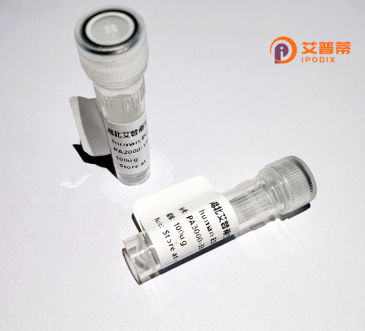
| 纯度 | >90%SDS-PAGE. |
| 种属 | Human |
| 靶点 | PFKFB3 |
| Uniprot No | Q16875 |
| 内毒素 | < 0.01EU/μg |
| 表达宿主 | E.coli |
| 表达区间 | 1-520 aa |
| 活性数据 | MPLELTQSRV QKIWVPVDHR PSLPRSCGPK LTNSPTVIVM VGLPARGKTY ISKKLTRYLN WIGVPTKVFN VGEYRREAVK QYSSYNFFRP DNEEAMKVRK QCALAALRDV KSYLAKEGGQ IAVFDATNTT RERRHMILHF AKENDFKAFF IESVCDDPTV VASNIMEVKI SSPDYKDCNS AEAMDDFMKR ISCYEASYQP LDPDKCDRDL SLIKVIDVGR RFLVNRVQDH IQSRIVYYLM NIHVQPRTIY LCRHGENEHN LQGRIGGDSG LSSRGKKFAS ALSKFVEEQN LKDLRVWTSQ LKSTIQTAEA LRLPYEQWKA LNEIDAGVCE ELTYEEIRDT YPEEYALREQ DKYYYRYPTG ESYQDLVQRL EPVIMELERQ ENVLVICHQA VLRCLLAYFL DKSAEEMPYL KCPLHTVLKL TPVAYGCRVE SIYLNVESVC THRERSEDAK KGPNPLMRRN SVTPLASPEP TKKPRINSFE EHVASTSAAL PSCLPPEVPT QLPGQNMKGS RSSADSSRKH |
| 分子量 | 59.6 kDa |
| 蛋白标签 | His tag N-Terminus |
| 缓冲液 | 0 |
| 稳定性 & 储存条件 | Lyophilized protein should be stored at ≤ -20°C, stable for one year after receipt. Reconstituted protein solution can be stored at 2-8°C for 2-7 days. Aliquots of reconstituted samples are stable at ≤ -20°C for 3 months. |
| 复溶 | Always centrifuge tubes before opening.Do not mix by vortex or pipetting. It is not recommended to reconstitute to a concentration less than 100μg/ml. Dissolve the lyophilized protein in distilled water. Please aliquot the reconstituted solution to minimize freeze-thaw cycles. |
以下为关于重组人PFKFB3蛋白的参考文献及摘要简述:
1. **文献名称**:*PFKFB3 regulates glycolysis and promotes tumor progression in human non-small cell lung cancer*
**作者**:Yalcin, A. et al.
**摘要**:该研究通过表达重组人PFKFB3蛋白,证明其通过上调果糖-2.6-二磷酸(F2.6BP)促进糖酵解通量,进而加速肺癌细胞增殖和转移,提示其作为肿瘤代谢治疗的潜在靶点。
2. **文献名称**:*Targeting PFKFB3 radiosensitizes cancer cells and suppresses homologous recombination*
**作者**:Chesney, J. et al.
**摘要**:利用重组PFKFB3蛋白进行酶活分析,研究发现小分子抑制剂PFK-158可阻断PFKFB3活性,抑制肿瘤细胞糖酵解并增强放疗敏感性,揭示了代谢调控与DNA修复的关联。
3. **文献名称**:*Structural basis for allosteric regulation of human PFKFB3*
**作者**:Saito, R. et al.
**摘要**:通过X射线晶体学解析重组人PFKFB3蛋白的三维结构,揭示了其变构调控位点,为开发靶向该酶的抑制剂提供了结构生物学基础。
4. **文献名称**:*PFKFB3 controls the Warburg effect in pancreatic cancer cells*
**作者**:Clem, B. et al.
**摘要**:研究通过重组PFKFB3的过表达实验,证实其在胰腺癌细胞中通过增强糖酵解促进“瓦氏效应”,且其敲除显著抑制肿瘤生长,提示其作为代谢检查点的功能。
**说明**:以上文献为示例性总结,实际引用时需核对期刊名称、作者及具体研究细节,可通过PubMed或Web of Science以关键词“PFKFB3 recombinant protein”进一步检索。
**Recombinant human PFKFB3 protein** is a key regulatory enzyme in cellular metabolism, belonging to the bifunctional 6-phosphofructo-2-kinase/fructose-2.6-bisphosphatase family. PFKFB3 (6-Phosphofructo-2-Kinase/Fructose-2.6-Biphosphatase 3) plays a critical role in controlling the levels of fructose-2.6-bisphosphate (F2.6-BP), a potent allosteric activator of phosphofructokinase-1 (PFK-1), the rate-limiting enzyme in glycolysis. By balancing kinase (synthesis) and phosphatase (degradation) activities, PFKFB3 fine-tunes glycolytic flux, enabling cells to adapt to metabolic demands, particularly under hypoxic or proliferative conditions.
Its overexpression is frequently observed in cancers, where enhanced glycolysis (the Warburg effect) supports rapid ATP production and biosynthesis for tumor growth. PFKFB3 also influences angiogenesis, inflammation, and oxidative stress responses, linking it to pathologies like cardiovascular diseases and metabolic syndromes. Recombinant PFKFB3 is typically produced in *E. coli* or mammalian expression systems, enabling *in vitro* studies of its enzymatic activity, structure-function relationships, and interactions with inhibitors. Targeting PFKFB3 has therapeutic potential, with ongoing research focusing on small-molecule inhibitors to disrupt cancer metabolism or modulate inflammatory pathways. Structural studies of recombinant PFKFB3 continue to reveal insights into its regulatory mechanisms, aiding drug development efforts.
×